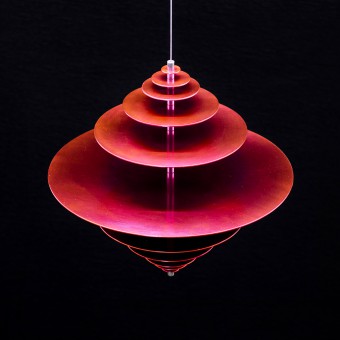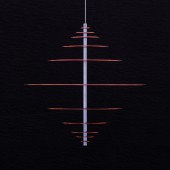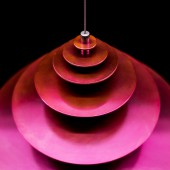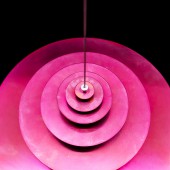
| THE AWARD |
| CATEGORIES |
| REGISTRATION |
| SUBMIT YOUR WORK |
| ENTRY INSTRUCTIONS |
| TERMS & CONDITIONS |
| PUBLICATIONS |
| DATES & FEES |
| METHODOLOGY |
| CONTACT |
| WINNERS |
| PRESS ROOM |
| GET INVOLVED |
| DESIGN PRIZE |
| DESIGN STORE |
| THE AWARD | JURY | CATEGORIES | REGISTRATION | PRESS | WINNERS | PUBLICATIONS | ENTRY INSTRUCTIONS |
The Big Bounce Object Astrophysics Theory Sculpture by Timo Brunkhorst |
Home > Winners > Design #59918 >Interview |
 |
|
FS: What is the main principle, idea and inspiration behind your design?
TB: The Big Bounce Object visualizes our universe and the life cycle. It combines the current scientific knowledge about our universe, the Big Bounce Theory and reflects it in a symmetrical object under considering the Fibonacci sequence.
FS: What has been your main focus in designing this work? Especially what did you want to achieve?
TB: This object represents a theoretical model of the origin of the universe (the big bang). The Big Bounce Theory is one of several theories, dealing with the temporal ending and beginning of the universe and describes an oscillation of space and time. (cf. Wikipedia (ed.) (2016). Big Bounce. Online: https://de.wikipedia.org/wiki/Big_Bounce (Access 05.10.2016). The object illustrates the familiar three dimensions (length, width and height) known to us, and brings out the strong interrelation between time and space as well. The symmetrical and quadratic structure was visually focused in the design. The basis for this is the expansion and the age of our universe in combination with the Fibonacci sequence.
FS: What are your future plans for this award winning design?
TB: I want to exhibited the object and searching for opportunities to do it. I am up for new things and open to what comes next, whatever it may be.
FS: How long did it take you to design this particular concept?
TB: From the idea to the final object took me round about 6 to 8 month.
FS: Why did you design this particular concept? Was this design commissioned or did you decide to pursuit an inspiration?
TB: I am very interested in astrophysics and i read a lot about this kind of topic and at one point i thought i have to built an object about a familiar theory. I choose a theory about the big bang, (the big bounce theory). I wanted to combine a symmetrical and quadratic structure in general with the current scientific knowledge about our universe, the big bounce theory and the Fibonacci sequence.
FS: Is your design being produced or used by another company, or do you plan to sell or lease the production rights or do you intent to produce your work yourself?
TB: No it is a one of a kind object and can only be bought ones.
FS: What made you design this particular type of work?
TB: My passion and interest for science and new things.
FS: Who is the target customer for his design?
TB: Everybody who is interested in science and information design and of course design in general.
FS: What sets this design apart from other similar or resembling concepts?
TB: It is very scientifical influenced, structured, precise built up and in one kind more or less an information object.
FS: How did you come up with the name for this design? What does it mean?
TB: I like to describe the thinks like they are. The name is the exact description of its meaning.
FS: Which design tools did you use when you were working on this project?
TB: Adobe Creative Suite.
FS: What is the most unique aspect of your design?
TB: The material and its color.
FS: What is the role of technology in this particular design?
TB: If there was much more progress in the field of astrophysics technology, maybe i had made a totally different object because of more or other theories about space and time.
FS: Is your design influenced by data or analytical research in any way? What kind of research did you conduct for making this design?
TB: Yes by the current scientific knowledge about our universe, the big bounce theory in detail and the Fibonacci sequence.
FS: What are some of the challenges you faced during the design/realization of your concept?
TB: The symmetrical and quadratic structure was visually focused in the design from the beginning. But after the first attempts to combine the current scientific knowledge about our universe, the Big Bounce Theory and the Fibonacci sequence, there was no symmetrical structure. After a couple of days of trying, i figured out how i have to put the 4 parameter together. And the finishing of the copper discs, through sawing, grinding and polishing by hand. Especially the color gradient on the copper discs took a long time to figure out, which one fits my ideas best.
FS: What did you learn or how did you improve yourself during the designing of this work?
TB: I liked on this object to work more scientifically and as a conclusion for myself I would like to work more often like this in the future..
FS: Thank you for providing us with this opportunity to interview you.
A' Design Award and Competitions grants rights to press members and bloggers to use parts of this interview. This interview is provided as it is; DesignPRWire and A' Design Award and Competitions cannot be held responsible for the answers given by participating designers.
| SOCIAL |
| + Add to Likes / Favorites | Send to My Email | Comment | View Press-Release | Translations |





